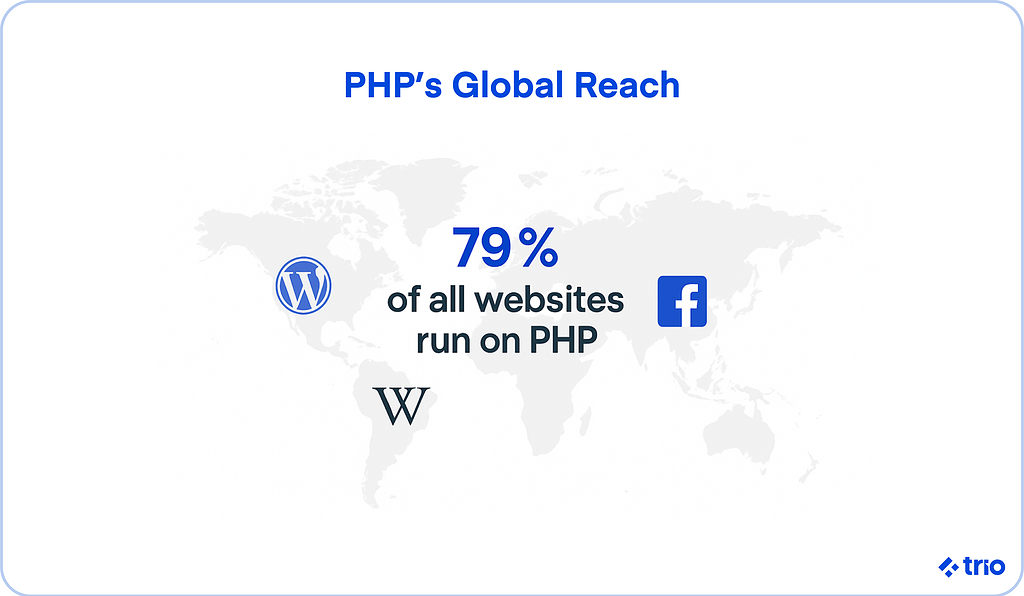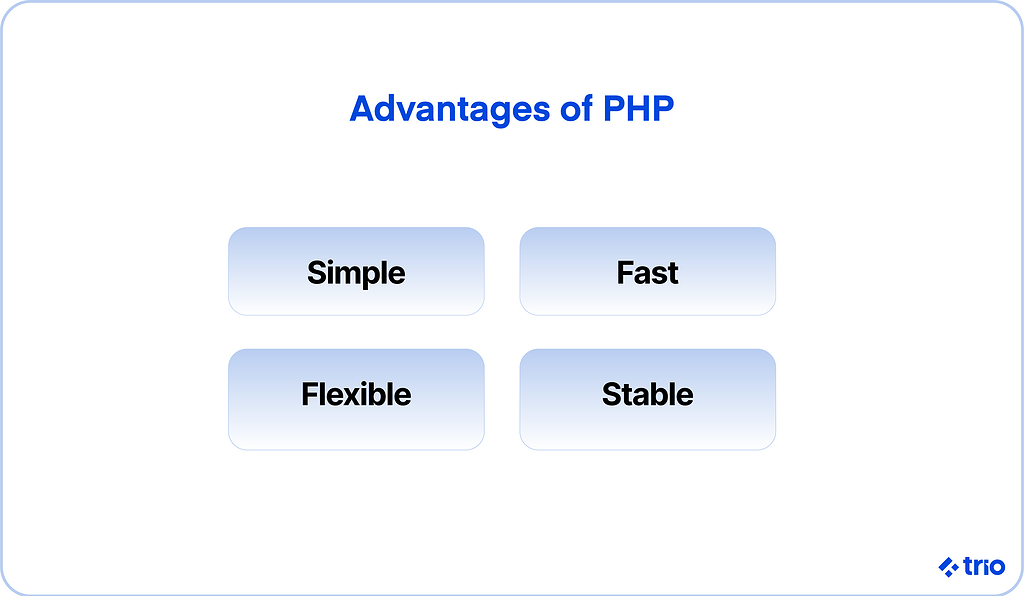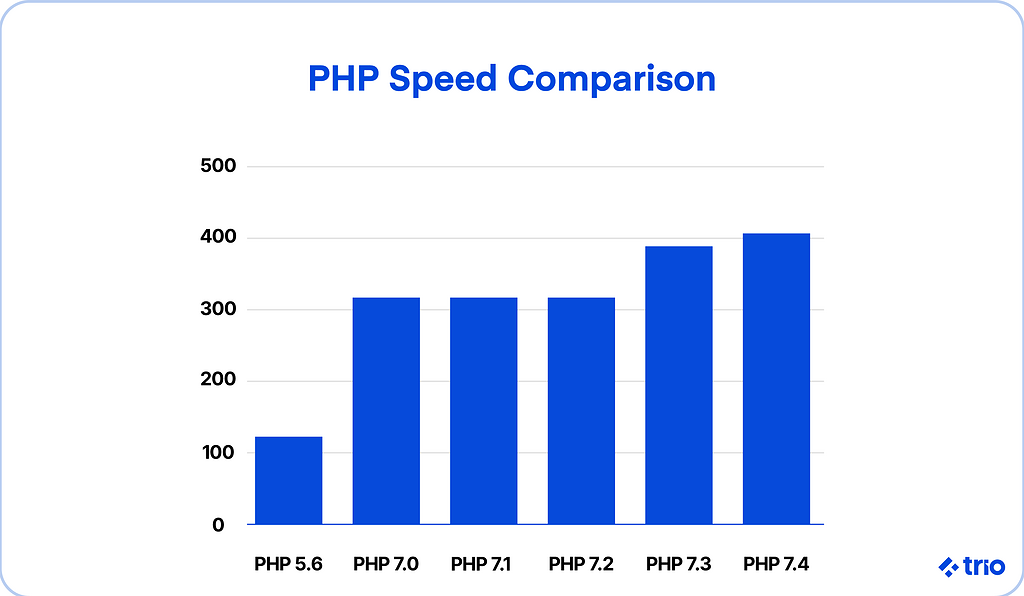In an era where elite organizations rely on large-scale, intimidating tech stacks for their backend, many people still struggle to believe that PHP can be used for major, successful projects.
But you’d be surprised. What do rising Fortune 500 tech startups and corporate giants such as Facebook, MailChimp, Slack, and Etsy all have in common? They’re companies that use PHP in their end-to-end computing infrastructure.
Whether it’s Lyft using PHP to run one of the world’s largest ride-sharing databases or Slack deploying PHP for the majority of its server-side application logic, PHP provides world-class support for building mobile and web products of all sizes.
Today, PHP powers more than 79% of all websites worldwide, including some of the most innovative startups and global platforms. With the release of PHP 8.3, the language has become faster, more secure, and more developer-friendly than ever before. Far from being “dead,” PHP continues to evolve and deliver results at scale.

Today, you’ll find out about seven global websites using PHP, including:
- Wikipedia
- Tumblr
- Slack
- MailChimp
- Etsy
- WordPress
- Shopify
- Upwork
If there’s anything you gain from this article, it should be this:
PHP is here to stay with an ever-increasing demand amongst some of the most prominent tech leaders in the global economy.
Please keep reading to learn more about leading companies that use PHP in their development workflows.
Are you ready to start your development project?
We have the developers you need to take your development project in the right direction.
Companies are proven to grow their business faster with Trio.
What is PHP?
Starting as a small open-source project way back in 1994, Rasmus Lerdorf unleashed PHP as an intuitive server-side scripting language.
Here’s a short and sweet rundown of PHP:
- PHP is an acronym for “Hypertext Processor”
- It’s widely used in small and large industrial applications, existing as an open-source scripting language
- PHP scripts are executed directly on the server end
- Its compilers and extensions are free to download and use
Similar to any other staple scripting language, PHP allows software developers to directly integrate logic into the creation of web page content and efficiently manage data returned from a web browser.
PHP also contains numerous out-of-the-box extensions that make it easy for software engineers to interact with databases. Frameworks like Laravel, Symfony, and CodeIgniter have modernized PHP development, making it faster and more scalable for businesses of all sizes.
The language is intuitively designed to extract relevant data for display on a web page, storing any information entered by a website visitor in its corresponding database defined by its script.
Instead of focusing on its early history, it’s more useful in 2025 to look at what PHP delivers now: cross-platform compatibility, easy integration with databases, and a mature ecosystem that supports everything from small business websites to enterprise applications.
All in all, PHP consists of two simple moving parts: a scripting language and an interpreter.
Web and PHP developers can utilize scripts to define server-side behavior and logic they need in a web app.
These scripts can be conveniently embedded into HTML markup documents that are served at the front-end of the web server.
An interpreter behaves as a backend module that integrates into the web server.
It actively converts scripts into explicit commands that the computer executes to achieve outputs defined in the script by the web developer.
In practice, this means PHP remains one of the most flexible and accessible languages for building dynamic web applications in 2025.
Main functions of PHP
PHP can seamlessly perform the following functions:
- Generating dynamic page content that can be easily updated
- Creating, opening, reading, writing, and terminating files on the server
- Ability to collect form data (a pretty popular application, by the way!)
- Sending and receiving cookies
- Used for controlling user access
- Encrypting sensitive user data
What Are the Advantages of Using PHP?
Before diving into the business-level advantages of PHP, take a look at a few of its leading qualities as a server-side programming language:
- PHP has cross-platform applications, running on Windows, Linux, Unix, Mac OS X, and an array of other supported operating systems
- It’s compatible with nearly all modern servers (e.g., Apache, IIS, etc.)
- It is open-source and free to use. You can download it officially at https://php.net.
- PHP is easy to learn and runs/modulates efficiently on the server-side
In 2025, PHP also comes with performance improvements through PHP 8.3, stronger typing options, and active community-driven security updates that keep it competitive with newer languages.

The business-level impact of integrating PHP into your company’s server-side app development cycle is much more exciting.
PHP wins over developers by saving your budget and time while still empowering teams with flexibility and scalability.
Some advantages include:
PHP’s Open-Source Delivery Saves Budget
Although open-source programming languages in the 21st century are not unfamiliar to the average developer, it is a particularly unique advantage for companies looking to scale their PHP development workflow.
PHP is available for free and requires no download or licensing fees. This accessible distribution brings about a large and active international community.
The result of an open-source software community that’s nearly three decades old is continual enhancements in functionality and an expanding pool of resources and facilities.
Developers no longer have to ‘reinvent the wheel’ because hundreds of viable, out-of-the-box PHP-based solutions are being released every year.
Today, the ecosystem includes mature frameworks (Laravel, Symfony), package managers (Composer), and CMS platforms (WordPress, Drupal, Magento) that drastically reduce time to market.
PHP Development Saves Time
Created as a partially object-oriented language, PHP makes code as reusable as possible.
Reusable PHP components save hours of time and effort in the software development cycle.
PHP frameworks, such as Symfony, CodeIgniter, Laravel, Joomla, and WordPress, carry functionality and offer efficient and secure development processes that alleviate the stress for everyone on the team.
Since its founding, PHP has been optimized for programming various web applications through built-in GET and POST functions, as well as HTML and URL script functionality.
For businesses, this saved time translates to decreased busywork and a return on investment sooner rather than later.
Modern features such as Just-In-Time (JIT) compilation and typed properties in PHP 8+ further accelerate development and performance.
PHP Code Is Flexible and Integrative
As highlighted earlier, PHP code is cross-platform. You can run and deploy PHP on major operating systems, including Windows, Unix, Linux, and macOS.
PHP’s server-side versatility is even better.
PHP’s backend supports servers including Apache, Microsoft IIS, Netscape, iPlanet, Caudium, Xitami, and Tornado, along with more than 20 databases like MySQL, MongoDB, PostgreSQL, and many others.
With PHP, businesses can seamlessly build cross-platform applications without worrying about compatibility errors.
Organizations can now leverage existing tech infrastructure with little to no expenditures.
In addition, PHP integrates easily with cloud environments and modern DevOps pipelines, making it a practical choice for hybrid and multi-cloud deployments.
PHP’s Lightning Speed Performance Helps To Retain Customers
To effectively retain website audiences, page loading speed is crucial.
Unfortunately, the human attention span is limited to around 6-8 seconds. If a website’s databases are slow, users will quickly exit, leaving a bad impression.
However, PHP ensures quick turnaround times by utilizing fast data processing features, excellent customization potential, and efficient integration with a variety of custom management systems.

With PHP 8.3 benchmarks showing significant gains over PHP 7, modern PHP applications can handle more requests per second with lower latency. Companies like Tumblr and Wikipedia reported measurable improvements in load times after migrating to newer PHP versions.
Given that PHP was initially developed with dynamic web page generation in mind, its scripts can solve real-time problems much quicker than other static scripting languages.
PHP scripts can be easily embedded into HTML files, allowing developers to convert existing static website code into dynamic front-end apps just by integrating PHP.
Overall, PHP is an excellent programming language for the creation of full-fledged websites based on static HTML.
10 Global Websites That Use PHP
There are so many global websites and companies using PHP that it would be impossible to go over them all. Instead, let’s look at the top 10.
1. Facebook
Perhaps the most notorious social media web application, with more than 2.11 billion daily active users, Facebook was developed primarily using PHP.
Facebook has taken advantage of PHP’s capability to generate dynamic content in mere seconds since its founding in 2004.
At its conception, the entire core Facebook application code was written in PHP by both Zuckerberg and Moskowitz. This led to a domino effect, and now a large pool of present-day tech companies use PHP as well.
Facebook introduced HipHop for PHP (HPHPc) in 2010, a transpiler that translates source code into source code of another language.
In HipHop for PHP, input PHP code is translated to C++ and then compiled into a binary for execution.
Eventually, HipHop for PHP was discontinued and replaced by the HipHop Virtual Machine (HHVM) in 2013.
This drastically improved performance and facilitated easier development and deployment processes.
Today, Facebook continues to use a highly customized version of PHP, supported by HHVM and Hack (a PHP-derived language), to scale to billions of users.
2. Wikipedia
Wikipedia is perhaps one of the most visited public information sites that uses PHP as a programming language, along with MySQL/MariaDB as its database backend.
Comparable to Facebook, in 2014, they switched to HHVM and loaded page data nearly twice as fast.
As of 2025, Wikipedia continues to run on supported PHP variants, optimized for HHVM, ensuring that its 4.4 billion monthly global visits are served quickly and reliably.
3. Tumblr
The birthplace of memes, the Tumblr community has generated over 620 million blogs.
In 2016, Tumblr transitioned to PHP7, noting dramatic performance upticks and new language features that they’re now able to implement, including scalar type hints and return type declarations.
Tumblr has since adopted PHP 8, citing further improvements in request handling and resource efficiency.
Related read: 15 Companies That Use Node.js Successfully
4. Slack
Established as the go-to team communications app in 2009, Slack’s valuation hovered around 4 billion dollars, and it’s actively used by over 3 million users daily.
Slack deploys PHP in its backend to maximize workflow efficiency, thereby speeding up web request time and minimizing program defects.
In 2025, Slack reports over 42 million daily active users, supported in part by PHP’s flexibility and its ability to integrate seamlessly with other backend services.
5. MailChimp
It’s no wonder that one of the primary leaders in the email marketing industry uses scalable PHP databases in its backend.
As of 2014, MailChimp uses PHP to actively send more than 400 million emails for its 7 million registered users.
Today, MailChimp (acquired by Intuit) serves millions of small businesses and sends billions of emails each month, with PHP continuing to power critical backend processes.
6. Etsy
Etsy has gained ground as one of the most popular retail PHP websites in the US, with more than 95.5 million active buyers.
This establishes Etsy as one of the largest e-commerce sites built on PHP. Among the top companies that use PHP, Etsy is the most competitive organization using it in the retail sector.
They actually documented their experimentation with HHVM for webpage performance optimizations.
Additionally, they released Phan, a static analyzer that can automatically recognize incompatibilities between PHP 5 and PHP 7.
7. WordPress
Ultimately, it’s no surprise that the most extensive content management system uses PHP to interact with databases and fetch data.
In short, PHP is used to fetch key components from the database and output them as static HTML.
This allows millions of active daily users to create/use templates, as well as drag/drop website UI components, with little to no coding experience.
WordPress now powers more than 43% of all websites on the internet, cementing PHP’s dominance in the CMS market.
Related read: React Native – 12 Examples of Successful Apps
8. Shopify
Shopify is one of the largest e-commerce platforms in the world, enabling millions of merchants to sell products online. The platform is built on a mix of technologies, but PHP plays a key role in its backend architecture.
PHP enables Shopify to securely handle massive amounts of data and transactions, from processing payments to managing product catalogs.
With more than 4.82 million live stores and billions in sales every year, Shopify demonstrates PHP’s ability to scale high-performance e-commerce applications.
9. Pinterest
Pinterest, the visual discovery engine, serves over 578 million monthly active users who pin and share billions of images. PHP powers much of Pinterest’s web infrastructure, enabling rapid content delivery and efficient database management.
Engineers at Pinterest have since stated moving some components to Java and similar languages to handle traffic spikes and complex search queries, underscoring how adaptable the language remains for large-scale social platforms.
In 2025, Pinterest continues to rely on PHP to keep its platform responsive and engaging, especially its legacy components.
10. Upwork
Upwork, the world’s largest freelancing marketplace, connects more than 18 million registered freelancers with businesses seeking talent. PHP underpins significant portions of its backend system, from user account management to secure job posting and payment processes.
By leveraging PHP’s flexibility, Upwork supports millions of transactions and collaborations across borders every year. Its sustained growth proves PHP’s ongoing relevance for complex marketplace platforms.

Subscribe to learn more about Hiring
Conclusion
PHP’s dynamic nature as a scripting language has allowed companies to save hours in lost daily time, allowing them to maximize long-term ROI.
With the recent rise of PHP8+ and its consistent popularity as a server-side language amongst top tech and retail companies, one thing is abundantly clear:
PHP should be seriously considered by business and software development teams.
Regardless of how these top seven companies employed PHP in their dev stack, they ensured that top-level talent got the job done.
At Trio, our senior PHP developers possess the technical intuition to build dynamic server-side backends for your web and mobile products.
Reach out to us today and learn more about how to hire a PHP developer with Trio.
FAQ
Is PHP still relevant in 2025?
Yes. PHP remains relevant in 2025, powering over 79% of all global websites that utilize a server-side language. The release of PHP 8.3+ also indicates ongoing support.
Why do companies still use PHP instead of switching to newer languages?
There are several reasons why companies continue to use PHP rather than switching to newer languages. Still, the main reason is that it is cost-effective, scalable, and backed by decades of community support. Migrating large systems is expensive and risky, but more importantly, PHP has continued to evolve.
What are the biggest websites that use PHP today?
Some of the biggest websites that use PHP today include Facebook, Wikipedia, WordPress, Shopify, and Slack.






